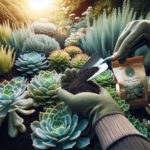Introduction to Sedum Plants
Welcome to the world of Sedum, lovingly known as Stonecrop, where the greenery meets low-fuss care and resilience. These plants are a gardener’s delight, with their ability to thrive in rocky nooks and sun-drenched corners of outdoor spaces, bringing life to garden landscapes effortlessly. The popularity of sedum isn’t just hype—it’s the culmination of its eye-catching allure and its admirable ability to thrive with minimal pampering.
Yet, even the hardiest plants have their secret needs. Observant gardeners know that beneath the tough exterior, sedum plants harbor a soft spot for nutrition that sustains their vibrant color and succulent leaves. It begs the question: should sedum be fertilized? Does the key to unlocking their growth potential lie in a bottle of nutrients, or are they as self-sufficient as they appear? It’s not just about adding more—it’s about understanding what truly nourishes these charming survivors of the plant kingdom.
For those eager to dive deeper into the care specifics of these robust beauties, explore our in-depth insights at Pruning Secrets that can elevate your gardening prowess. Moreover, to witness firsthand the simple joys and techniques of sedum care, I recommend indulging in this insightful video.
Video: Best Tips for Growing and Caring for Jelly Bean Plant (Sedum Rubrotinctum)
While sedums ask for little, what minimal care they do desire is pivotal for their continuous success in your garden. Discover more about caring for garden plants and sedum’s ability to flourish, even amongst the stones—showcasing nature’s resilience at its finest.
Understanding Sedum Nutrition
When it comes to tending to your vibrant Sedum, or Stonecrop, think of it like whipping up a gourmet meal for a discerning foodie. Just as a chef carefully selects the perfect balance of ingredients for flavor and nutrition, your Sedum craves a custom menu of nutrients to thrive. So, what’s on the plate for these succulent delicacies?
Imagine your garden as a boutique kitchen, crafting a special dish for your green friends. Sedum, for instance, gobbles up macronutrients like nitrogen (N), phosphorus (P), and potassium (K), the ‘holy trinity’ of plant nutrition. These are like the carbs, proteins, and fats of the plant world, fueling everything from their lush, juicy leaves to their starburst blooms.
Then, like a pinch of exotic spice, micronutrients enter the scene. Elements such as iron, manganese, and zinc might not be the headliners, but they’re the unsung heroes behind the scenes, ensuring your Sedum’s performance is a showstopper. They’re akin to vitamins in our diet, small yet mighty, performing essential roles that keep your Sedum jazzed up and ready to grow.
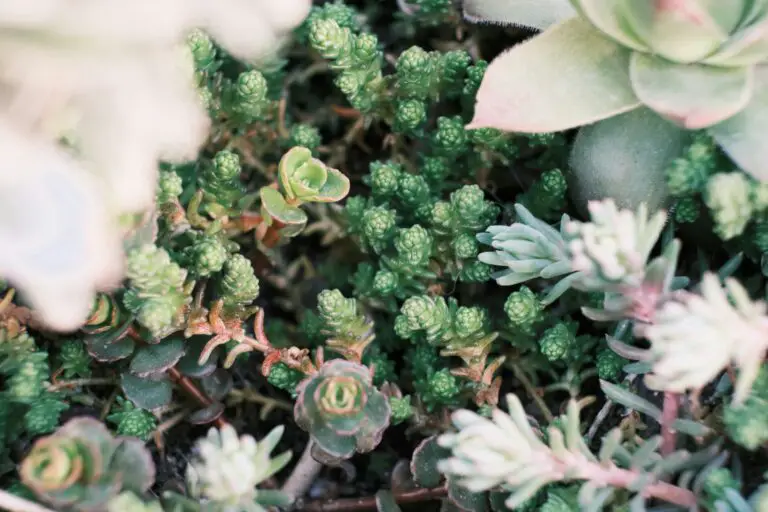
Let’s take a real-life example: you wouldn’t train for a marathon on a diet of cupcakes alone, right? Similarly, your Sedum can’t live up to its full potential with just any old soil. They need well-draining ground with a carefully calibrated nutrient mix that matches their unique tastes. Too much of a good thing, such as an overabundance of fertilizer, can send your Sedum into a tailspin, just like those sugar highs and subsequent crashes we all know too well.
The art of sedum cuisine lies in moderation and precision. By serving up the right mix of nutrients, you’re nurturing an oasis where your Stonecrop can strut its stuff. For an in-depth dive into the preferred nutrient palette of your Sedum, the experts over at Plant Addicts offer a comprehensive guide, ensuring you get the mix just right. Bon appétit, gardeners!
To Fertilize or Not to Fertilize
Imagine a resilient little sedum, perched high on a rocky ledge, basking in the sun, with nary a hint of rich soil in sight. It’s a scene straight out of a sedum’s natural habitat—a testament to the hardiness of these succulent beauties. But here’s the kicker: should we, the diligent gardeners of our leafy domains, step in and offer a boost in the form of fertilizer? This enigma has garden enthusiasts buzzing like bees in a bed of blooms.
On one hand, we have the purists who argue that sedums are as tough as old boots, capable of thriving on a diet of sunlight and sheer willpower. To them, the mere thought of adding fertilizer is like offering a mountain goat a treadmill—unnecessary and frankly, a bit silly. I mean, when was the last time you saw a stonecrop sipping on a nutrient-rich latte in the wild? Exactly. Gardening experts celebrate the sedum’s self-sufficiency, often advising plant parents to let nature run its course. Here lies the case against sending in the cavalry of compost and mineral troops.
Then, there’s the camp of encouragers who see fertilizer as the secret sauce to supercharge their succulents. They believe in a gentle nudge, a little snack for their sedum, if you will, to help it grow fuller, bloom brighter, and be the envy of every plant in the pot. They whisper sweet nothings to their plants about the grandeur of lush living and how a bit of fertilizer can pave a more verdant path.
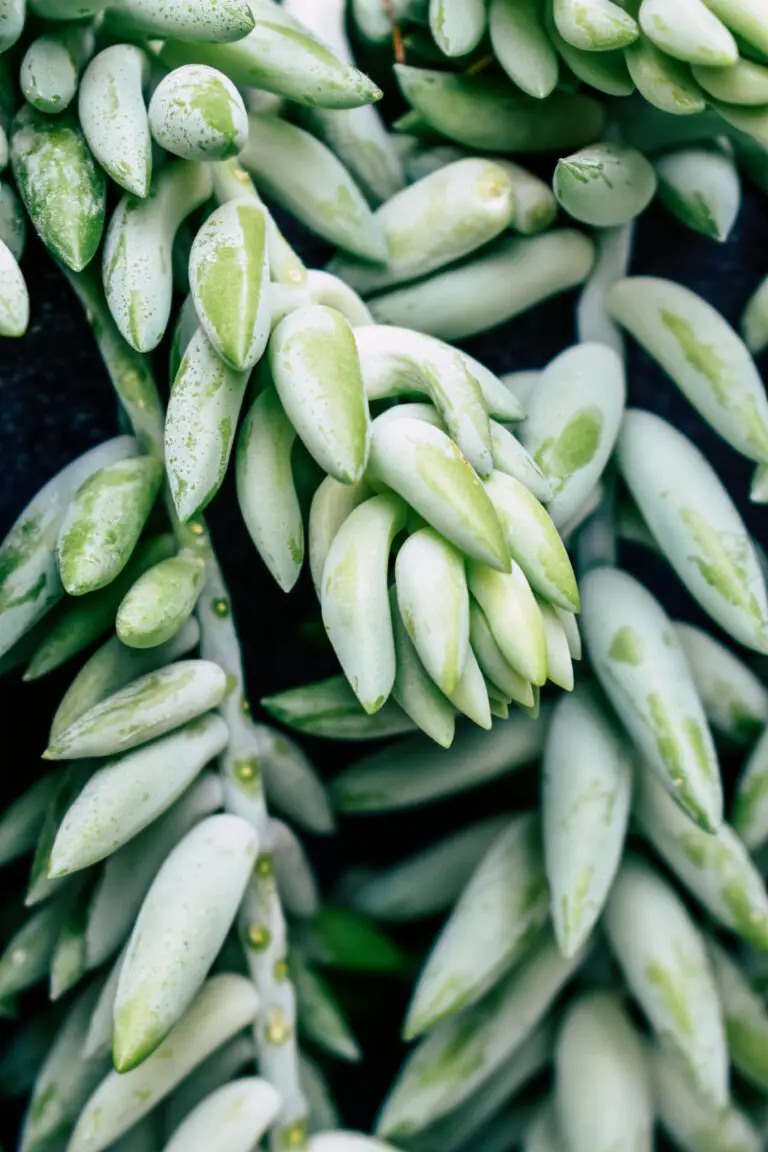
So, who’s to say what’s best? Perhaps the moderate voice of reason suggests a middle ground—fertilize with finesse, offer a taste without creating a feast. If you’ve got sedum that’s slouching, yellowing, or looking a touch malnourished, then yes, a little fertilizer magic might be in order. But beware the temptation to overdo it; this isn’t a Vegas buffet for your stonecrop. Keep it light, keep it balanced, and your sedum will tell you if it’s craving more.
For those with questions tickling their brains about how to best care for these stoic succulents, take a peek at our guide on perfecting your succulent’s hydration schedule. It’s full of tips that’ll keep your succulents sassy and satisfied, without overwhelming them with too much TLC.
In the great debate of whether to fertilize or not, the answer is nuanced, personal, and, frankly, as varied as the sedum species themselves. Treat your succulents like the individuals they are and tailor your approach to their whispers and whims. In the end, whether you fertilize or not, these hardy plants will likely flourish with the resolve of their wild ancestors, high on their rocky perches, come rain or shine.
Choosing the Right Fertilizer
Setting out to fertilize your sedum is akin to equipping a warrior for battle – the right armor makes all the difference. The great debate between organic and synthetic fertilizers is more than just a preference; it’s about understanding what suits your stonecrop’s ambition to thrive. You might ponder, “Will my sedum favor the slow and steady release of organics, or does it yearn for the immediate gratification of synthetic boosters?” Here’s how you make that pivotal choice.
Imagine you’re a chef carefully selecting spices for a signature dish; similarly, the nuanced selection of fertilizer for your sedum can elevate its growth to culinary artistry. Organic options, akin to heirloom spices, offer a slow infusion of nutrients and enrich the soil’s ecosystem, encouraging a symphony of microorganisms to dine alongside your sedum. Think compost, bone meal, or fish emulsion as your garden’s gourmet picks.
In contrast, synthetic fertilizers are akin to a dash of seasoning salt, invigorating the sedum with immediate, targeted nutritional prowess. Much like whipping up a meal in a flash, these can quicken the pace of growth and flowering, giving gardeners the fast-track to lush foliage and vibrant blossoms.
Yet, it’s not just about speed; it’s the art of balance. Overzealous feeding with synthetic options can lead to the botanical equivalent of a sugar rush, potentially causing more harm than help. On the other hand, organics may require patience but promise a gourmet feast for the soil that benefits your sedum’s long-term wellness.
As you ponder your choices, consider how your stonecrop’s proclivity for lean soil must influence your fertilizer regime. Sure, they crave those nutrients but in a ‘less is more’ kind of way. Imagine a robust sedum, its succulent leaves glistening in the sun, thanking you for not overwhelming it with nutrient-rich banquets better suited for hungrier plants. As you mold your fertilizing strategy, let insights from our other article on nutrient requirements for garden plants do some heavy lifting for you.
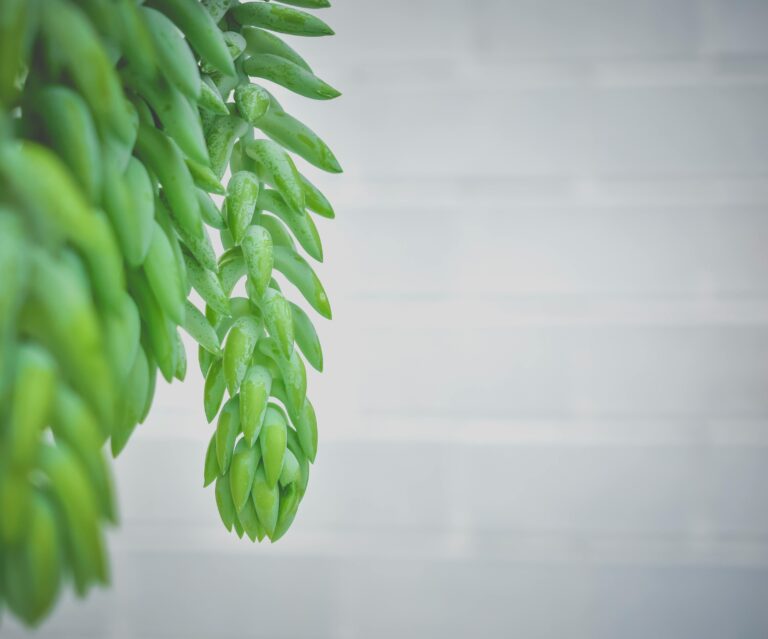
So, lean into the wisdom of moderation, where a careful choice of fertilizer becomes your ally in nurturing a sedum that flourishes with minimal intervention – a testament to the resilient beauty these stonecrops embody. Whether you choose to walk the organic path or decide on synthetic aid, your sedum’s resplendent glory will be a living mosaic of your gardening prowess. Select wisely, and watch your stonecrop come alive with vigor and blooms.
Should Sedum Be Fertilized? Nourishing Your Stonecrop for Growth
So, you’ve got yourself a stunning sedum, also known as stonecrop, and now you’re pondering the green-thumbed conundrum: to fertilize or not to fertilize? Well, let’s dig into the dirt on this topic and unearth some insights on how you can nurture your beloved sedum to thriving perfection.
Fertilization Techniques and Best Practices
Imagine you’re a chef in a garden-kitchen, and your sedum is the gourmet dish you’re prepping. Just like a dash of salt can enhance a dish’s flavor, a bit of fertilizer can invigorate your sedum. But here’s the twist – overseasoning can ruin a meal, and in the same way, you can easily spoil your sedum with too much love in the form of fertilizer.
Timing is everything when it comes to fertilization. The best moment to fertilize? That would be early spring, as your sedum stretches out from its winter slumber. As the butler of blooms, offer a balanced, slow-release fertilizer to your plant butler-style – with poise and moderation. And remember, once the growing season is at full tilt, it’s time to put the fertilizer away and let nature do its thing.
Let’s talk frequency. Just once a year is often enough for these hardy succulents. Consider the case of a friend who loved their sedum a bit too much and ended up with a lanky, overfed plant that couldn’t even hold its own weight – a botanical tragedy you want to avoid.
And as for quantity, think of it like seasoning – just right is might. A sprinkle per square foot of your garden bed should suffice. You see, sedums are like the camels of the plant world – they store water in their leaves, making them drought-resistant and rather unfussy about their diet. They thrive in tough love conditions, and too much fertilizer can lead to weak stems and a decrease in flower production. It’s a balance of giving them just enough to thrive but not so much that they get lazy.
Now, for those of you itching to see these practices in action, feast your eyes on this video that showcases the art of fertilizing sedum:
Remember, nurturing your sedum isn’t about showering it with nutrients; it’s about understanding its nature and fostering an environment where it can prosper on its own. So, take these tips, treat your sedum with a knowledgeable touch, and watch as it rewards you with robust growth and vibrant blooms. Happy gardening!
Potential Risks of Over-Fertilization
When it comes to nurturing sedums, a commonly held belief is that “a little goes a long way.” These succulent sensations bring joy to gardeners with their hardiness and vibrance. But, as with all good things in life, there can be too much of it – especially fertilizer. So, what happens when these tough little troopers get an overdose of nutrients?
Imagine pouring a cup of coffee, only to realize you’ve tipped the entire pot into your mug. That’s akin to what root burn is to sedums. It’s when the soil becomes a hotbed, not of growth, but of chemical stress. Sedum roots, which are built to withstand tough conditions, suddenly find themselves swimming in a cocktail of nutrients they can’t handle. They begin to singe and wither – a painful experience for any plant lover to witness. 
But the trouble doesn’t end there. Like a beacon, the over-fertilized soil sends signals to pests far and wide. “Feast here!” it inadvertently shouts. And before you know it, your sedum garden becomes a buffet for every critter and crawler in the vicinity. This is not the natural gathering you’d like around your stonecrop!
Lastly, let’s not forget that every superhero has a weakness. For sedums, excess fertilizer could very well be their kryptonite. With the onslaught of too many nutrients, their immune system takes a hit, leaving them vulnerable to diseases they would otherwise scoff at. It’s like watching a valiant warrior succumb to a common cold.
Gardening is about balance, a gentle give and take with nature. Over-fertilizing your sedum plants upsets this equilibrium, potentially leading to a series of unfortunate events that could’ve been avoided with a lighter hand. So next time you’re tempted to pamper your sedums with an extra spoonful of fertilizer, remember – moderation is key to the continued health and beauty of these resilient rock dwellers.
Monitoring Sedum Plant Health
When it comes to your flourishing sedum, think of yourself as the plant’s personal health coach. Keeping a close eye on your verdant companion is crucial to determine if your fertilization routine is hitting the mark. Sedum, a stoic survivor in the plant kingdom, doesn’t cry out for attention. However, subtle hints can reveal if it’s on a balanced diet or if you’ve been overindulging it. Let’s decode the signs together so you can tweak those fertilizer portions to perfection!
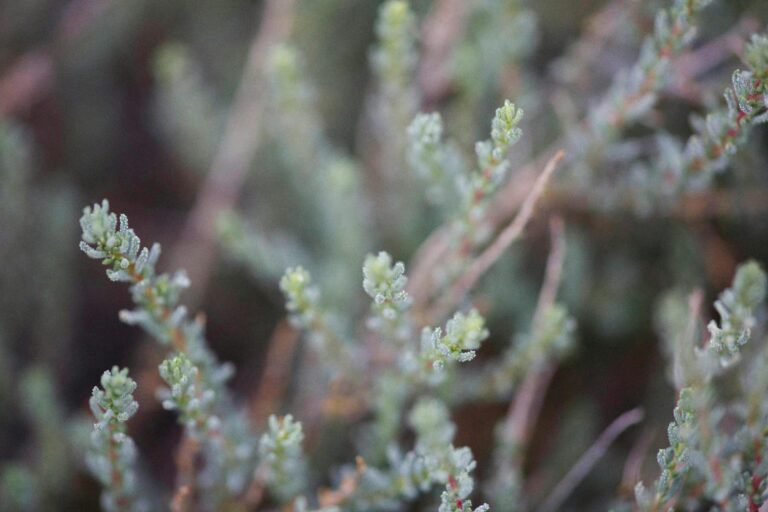
First up, let’s talk about an under-fed sedum. This isn’t a plant that will throw a tantrum if it misses a meal, but growth that’s more sluggish than a lazy Sunday might be your first clue. You may also notice the leaves are a bit lackluster, like a green that’s lost its groove. If the sprouts are as thin as a supermodel at fashion week, you’ve got another sign your sedum’s meal plan needs a boost.
Spotting Under-Fertilization
Picture this: Your stonecrop’s stems are stretching out like a yogi reaching for their toes—long and weak. That’s a surefire sign they’re searching for nutrients that aren’t there. And if the blooms are as sparse as a desert oasis, another red flag goes up. You want a sedum that’s lush and full, not one that looks like it’s been on a crash diet.
Identifying Over-Fertilization
On the flip side, there’s such a thing as too much love. Over-fertilization can make your sedum’s leaves brittle, like overcooked veggies at a buffet. A surplus of nutrients can also lead to excessively lush foliage with few flowers—think of it as all leaf and no bloom. Burnt-looking leaf tips can also speak volumes, whispering, “I’m full, thanks!”
Keep in mind; the best way to monitor sedum health isn’t just about eyeballing it—conducting regular soil tests can give you the insider info you need. Checking if it’s high noon in the nutrient department or a bit of a ghost town can help you adjust and serve up just the right menu for your stonecrop’s dietary needs. Remember, a happy sedum is all about balance—a little nurture, a touch of nature, and the perfect sprinkle of fertilizer.
Organic Alternatives to Fertilizers
When it comes to nourishing your sedum, also known as Stonecrop, you might be wondering if there’s a way to avoid traditional fertilizers and opt for a more natural approach. The answer is yes! Organic alternatives not only feed your plants but also bolster the ecosystem within your garden. So, should sedum be fertilized with organic options? Absolutely, and here’s how to do it.
Composting: Nature’s Own Fertilizer
One of the simplest yet most effective organic fertilizers is compost. Compost is the gold standard of organic gardening and plays a pivotal role in sedum care. Loaded with nutrients, it improves soil structure, which in turn, provides a healthy environment for sedums to thrive. Creating compost may remind you of cooking a special stew—just gather your kitchen scraps, like fruit and vegetable peels, coffee grounds, and eggshells, and let nature do the rest. A sprinkle of this “gardeners’ gold” around your sedum plants acts like a slow-release fertilizer, offering a steady supply of nutrition throughout the growing season.
Worm Castings: The Soil Supercharger
Imagine if you had a secret ingredient that could supercharge your soil with a slew of essential nutrients and beneficial microbes. That’s precisely what worm castings, or vermicompost, can do for your sedum garden. These nutrient-packed castings are produced by earthworms digesting organic matter, and they work like a charm for stonecrop. By lightly working them into the soil around your sedum or using them as a top dressing, you will not only fertilize but also improve soil aeration and moisture retention—an excellent example of nature working hand in hand with gardeners!
Integrating these organic alternatives into your sedum care routine mirrors the cycles found in nature, promoting sustainable gardening practices that enhance your garden’s overall health. For a vivid glance at the wonders of using organic matter in your garden, check out this insightful video:
To sum up, feeding your sedum with organic alternatives is not just about swapping out chemicals; it’s a philosophy that embraces the natural world’s rhythms. It’s about transforming waste into wealth, encouraging a living soil, and ultimately, growing resilient and vibrant sedums that are as healthy as they are stunning. So the next time you ponder over whether you should fertilize your sedum, remember that nature itself holds the most potent and life-affirming options.
Conclusion: Balancing Sedum Care
As we’ve delved into the world of sedums, it’s clear that these resilient stonecrop stars shine brightest with a touch of tender care. Just like a tightrope walker balances with precision, so must we find the sweet spot in fertilizing our sedums. It’s not about showering them with nutrients, but more about a thoughtful sprinkle to complement their robust nature.

Imagine a hearty sedum, steadfast in rocky terrain, with just enough sustenance to thrive without overindulgence. That’s the essence of sedum care—knowing that sometimes, less is indeed more. This approach prevents the lavish overgrowth that can lead to weak stems and fewer blooms. After exploring the dos and don’ts, the signs and signals, we see that balance is not a myth in the realm of sedum cultivation—it’s the golden rule.
Reflecting on real-life garden triumphs, it’s those minimalists, with their ‘less is more’ mantra, who often reap the most ornate and sturdy sedums. Think of fertilization as the occasional spice in an already flavorful dish; it should enhance, not overwhelm. By adopting this philosophy, you not only nurture the plant but also foster an environment where the sedum’s natural beauty is the main attraction.
Frequently Asked Questions
Got a green thumb for sedum plants but feeling stumped on the whole fertilization conundrum? Let’s dig through some dirt and unearth answers to the pressing questions that keep garden enthusiasts up at night. Whether you’re playing in the garden or pottering with pots indoors, here’s the scoop on feeding those sturdy stonecrops.
When’s the Best Time to Fertilize Sedum?
Nailing the timing is crucial, folks. Think Spring, when these succulent beauties begin their fresh bout of growth. A little fertilizer can go a long way to giving them a spurt of energy after a long winter’s nap. And if you missed the spring train, early fall can give you a second shot before the plants bundle up for winter again.
Spotting the Tell-Tale Signs of Nutrient Deficiencies
Plants are fairly good communicators when they’re feeling a bit under the weather. Yellowing leaves? Could be a nitrogen deficit. If the foliage is throwing out a purplish hue, phosphorus might be the missing guest at the dinner table. Sedum plants usually aren’t fussy eaters, but they’ll drop hints when they aren’t getting their nutritional fill.
Indoor vs. Outdoor Sedum: Does Care Differ?
Oh, it’s a whole different ball game with indoor and outdoor sedum. Your indoor squad will likely need less chow, enjoying their cozy life with regulated temps and indirect sunlight. But let them outdoors, and they’ll want a bit more grub to keep up with their active, sun-soaked lifestyle. It’s all about balance and not flipping the buffet table with too much enthusiasm.
For a visual guide on sedum care, have a look at this informative video:
Remember, whether your sedum is soaking up the sun by your walkway or basking in the softer rays on your windowsill, a little TLC with the right fertilization can ensure they remain the envy of the plant world. So, don those gardening gloves, fetch your fertilizer, and get ready to pamper your plants to their lush, leafy best!
